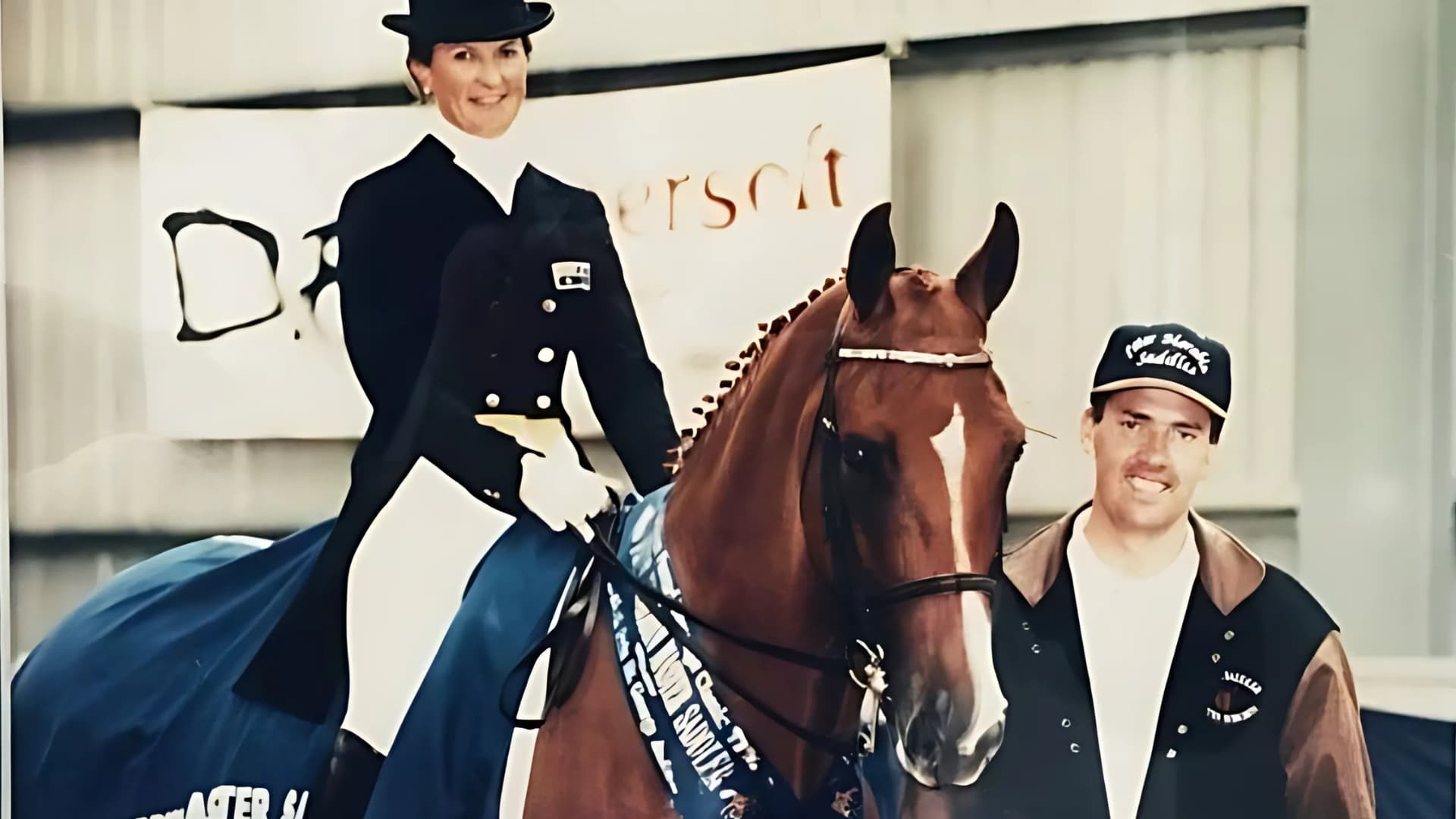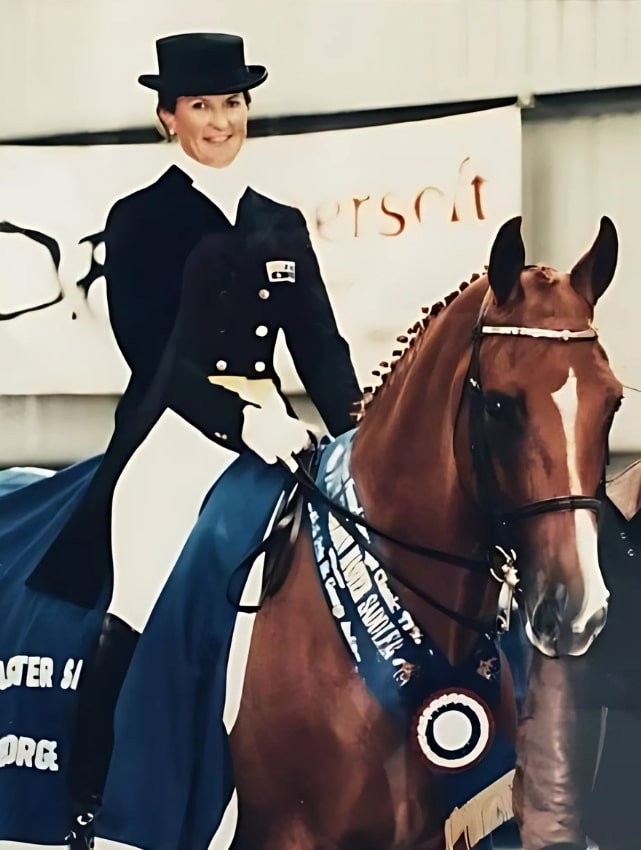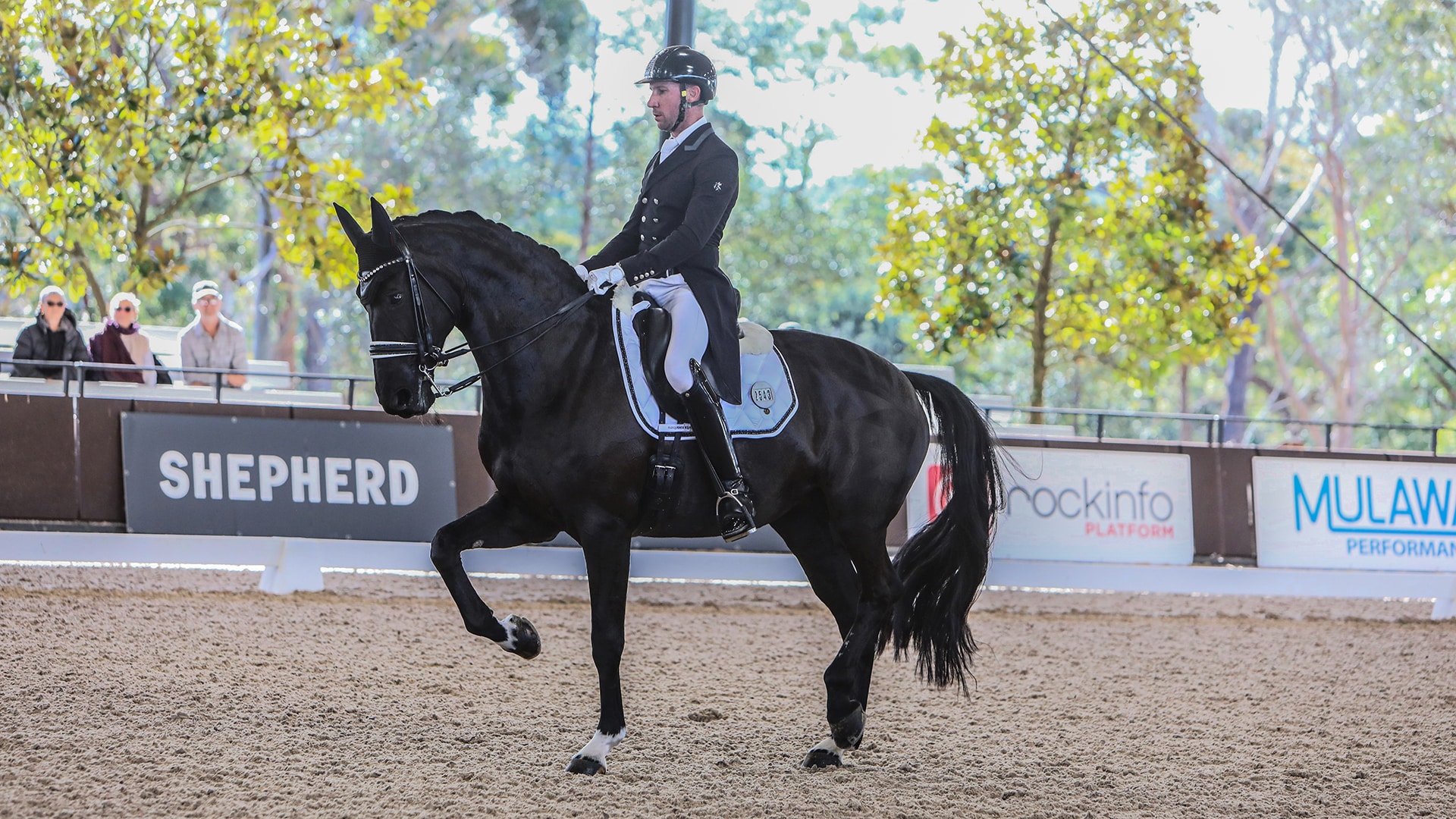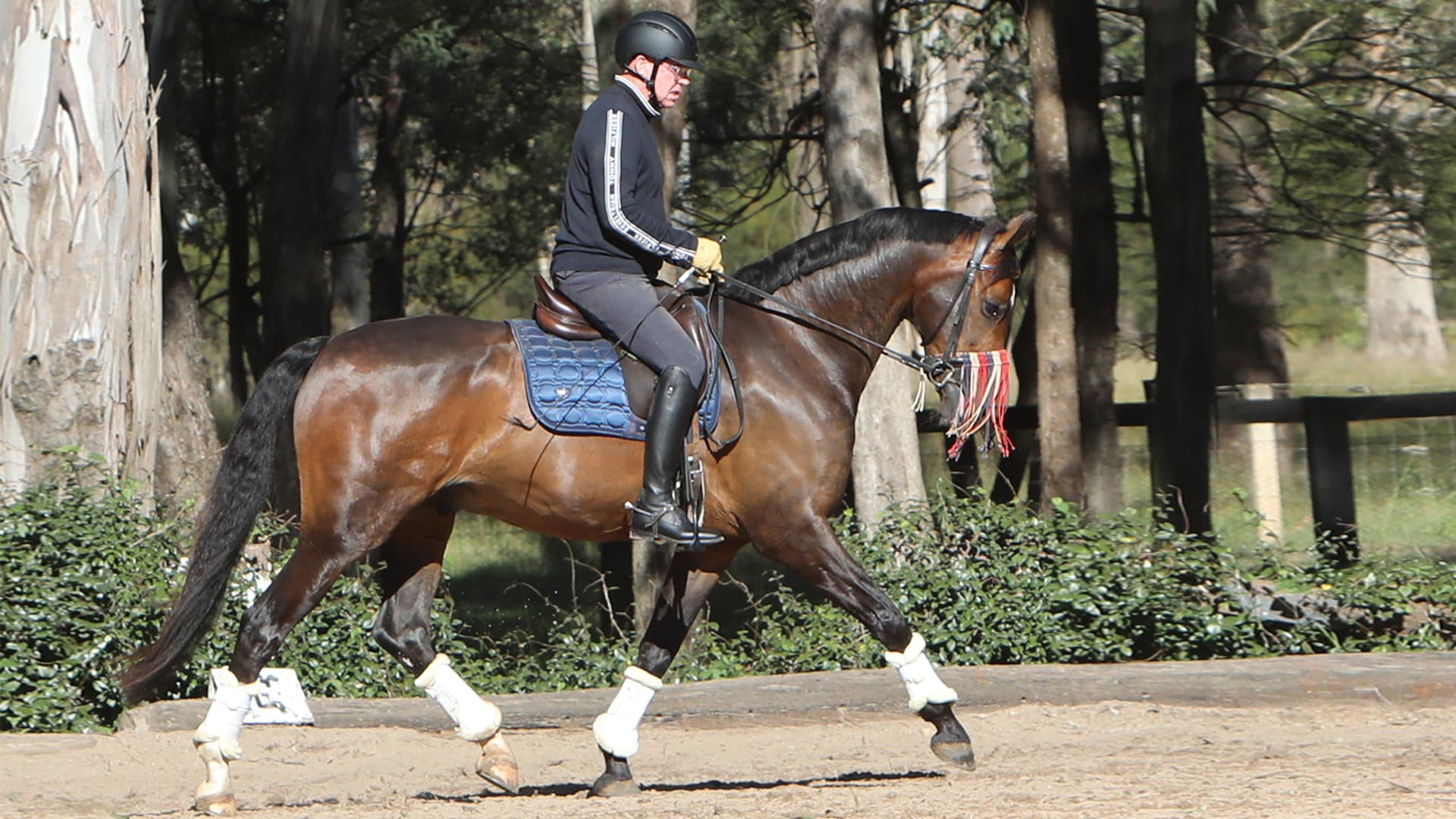Glennis Barrey was a pioneering dressage rider who forged her own path with determination and grit. From humble beginnings in South Africa to the international stage, she represented Australia with pride, built world-class facilities, mentored many, and faced life — and cancer — with fierce optimism, resilience, and unwavering belief in herself.
It is with a heavy heart and a lump in my throat that Glennis, my dear friend of 45 years, has passed. May this be – but rest assured that her presence, attitude to life and determination to stay focused on the road ahead will stay with me. She was always humble and always strived for the best she could be. Her life is a fabulous journey of a determined and single-minded woman who proved her worth and more!
This short version of 62 years of an amazing life was captured during the last months of Glennis’s time. I apologise for the amazing stories, horses and people I’ve missed.
BORN IN SOUTH AFRICA
Glennis’s parents, Don and Patsy, were born in South Africa, and Glennis was born in Malmesbury, halfway between Johannesburg and Cape Town. She had two older brothers, Dennis and Peter. Patsy was born on a farm in Botswana and Glennis well remembers the photo of her in front of her mother’s farm horse in a hand-me-down, hand-knitted jumper, a pair of thongs and no helmet but two pigtails.
It was on this farm that Glennis started riding. Her parents would take her to a local riding school near the famous Leilani racetrack. She would do odd jobs fetching horses for the farrier, cleaning stables and tacking up horses to earn a bit of money so she could spend it on a lesson.
Patsy – whose father was a policeman and mother was a farmer – used to work in the local trading shop and as a wedding organiser. She was also the vet and the doctor for locals. Don Scott lived in Cape Town, and after meeting Patsy, asked three times to marry her over the two years that followed – and it wasn’t until the third time that, according to Glennis, he caught Patsy at a weak moment, and she agreed! Don used to ride his bike to visit Patsy in those early days, a trip took two days. Glennis remembers Don saying he would stop and sleep in onion sheds and amongst onions to keep warm on the way there and back.
Don used to run a factory floor making glass that was exported to O’Brien’s Glass in Australia. When O’Brien’s got into financial difficulties, Don was asked to go and see if he could help them out in Australia, which he did. He was then offered a full-time job with O’Briens, and as a consequence loved Australia and decided to stay. Patsy and Glennis came out to be with him and the boys followed later.
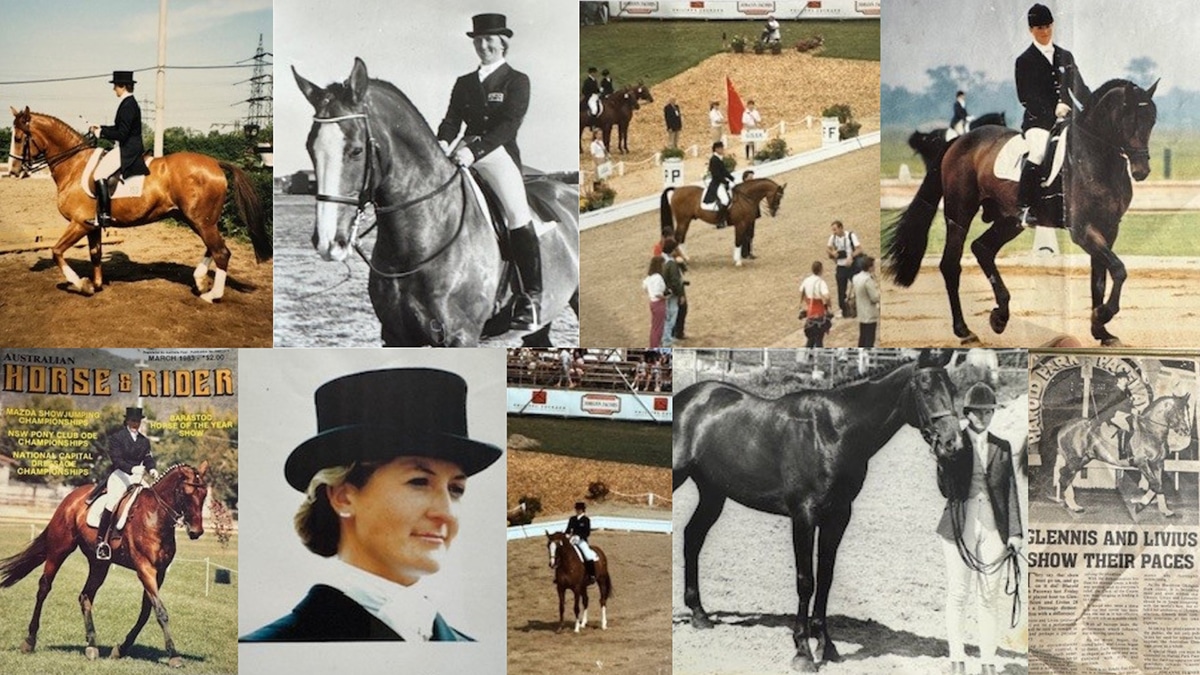
Glennis was a top-level Australian dressage rider who enjoyed a very successful international career.
SETTLED IN DURAL
When the family moved to Australia, they rented a house in Dural, an hour’s drive west of Sydney CBD. Later they bought property in Middle Dural.
At Dural, it was a western-type trainer, Diane Copp, who really started Glennis off. Glennis had a 15-hand mare that was difficult, but she loved to ride her as often as she could. Diane’s husband would pick up Glennis and her horse – as Glennis had no float or transport – take them to Diane’s for the lesson then return them home. Glennis was forever grateful for this introduction to the sport, and to Diane and husband for what they did for her. Again, Glennis did extra jobs for Diane and worked really hard. She admitted Diane was a hard task mistress, but she didn’t mind, and what she earned went towards more lessons with Diane.
Don kept working for O’Briens while Patsy established a commercial strawberry patch. Later, her son Dennis started a nursery on the property and that nursery still exists today. Sadly, Dennis – a great favourite of Glennis’s – and his wife her were tragically killed in a motor bike accident.
Glennis went to school at Tara then started work with Carolyn Lieutenant. While still training with Diane, Glennis had a Thoroughbred called Mr Chips and did some showing and low-level dressage with him. She then bought a Warmblood called Hinkler from Bev Chugg and rode him through the levels to Prix St Georges when she was 17. She was still part-time with Caroline when she got Hinkler and became keen on dressage. Don, being always one to look to the positives, decided that with Glennis’s progression and interest in dressage it would be best for her to go and train overseas, and so she headed to Germany.
This positive step was introduced through Gert Donvig. Gert had advertised that there was a clinic at his property at Macedon in Victoria with the trainer Bimbo Peilicke during Glennis’s school years and holidays. She had seen Gert and Mary Donvig (now Hanna) riding and was most impressed and their ways crossed paths.
Glennis spent some time during school holidays working and training with Mary and then an extended period before returning to work full-time with Carolyn Lieutenant. At this time, Glennis also bought a horse called Jewel Advocate. Glennis had actually broken in Jewel Advocate and took him and Hinkler to the clinic, where Bimbo really liked the gelding. Glennis then took both her horses to Germany for three months to train under the auspices of Bimbo.
Whilst in Germany, they purchased a great horse that did some low-level competition. Glennis was enjoying the experience in Germany, and it was decided with a lot of input from Don that Glennis should stay there longer as she was only just scratching the surface with her training and understanding. After a while it was decided that perhaps she should look for a horse in Germany to buy and compete on.
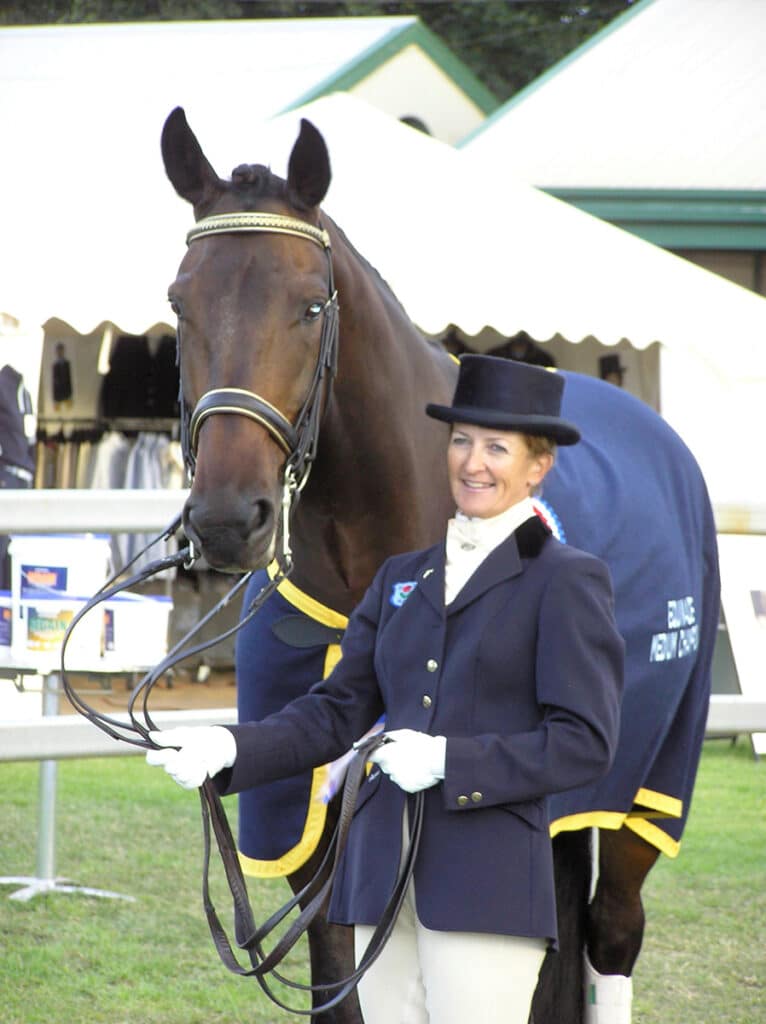
Glennis with another successful horse, Glenquarry, who was owned by Camilla Poolman.
TRAINING WITH BIMBO PEILICKE
With Hinkler and Advocate in Germany, and in training with Bimbo, I recently asked Glennis about the progress and training style. “Bimbo liked both horses, but decided he would have a ride one day on Hinkler,” Glennis recalled. “He wasn’t so keen after the ride on him! He thought Hinkler was a bit of a girl’s horse and needed to be put in his place a little bit, to which Hinkler said, ‘I think it’s time you part company with me’ and Bimbo ended up flat on his back! He wasn’t so keen on Hinkler after that!
“Advocate was going super well and very competent at Inter II, and then just before Grand Prix arrived, he had a series of minor injuries and that put him out. It was a great disappointment. Bimbo found a chestnut gelding, Livius, who was competing basically at Elementary level with light changes. He got a lot of work put into him and went on to Prix St Georges with Bimbo’s guidance.”
He wasn’t the world’s best mover, as Glennis explained, and he was always a little nervous in the arena when it came to competition. It was through working with Bimbo – and at that stage, Glenn Fryer was also training with Bimbo – it was decided that it would be good to get fresh eyes and move on to Udo Lange; Glennis spent exactly 12 months with Udo. Livius at that time had a problem with one tempi changes and Udo explained that he felt that he would never make a good competition horse because the one tempi changes were never going to happen.
Being South African, determined and quite pigheaded, Glennis set about doing tempi changes everywhere, as she had nothing to lose. Believe it or not, of course Glennis got the one tempi changes! Glennis actually managed to do 69 one tempi changes around an oval when the horse returned to Australia!
In Glennis’s words: “Don’t ever tell me something won’t happen. As I’ve explained before, ‘can’t’ isn’t in my vocabulary. I didn’t feel so much proud of myself in the success of getting one tempi changes, but I just want to make a point to people to never give up. You never know what might happen in the future with dedicated work.”
With Advocate having some soundness issues, Don thought it would be a good idea to get another back-up horse. The beautiful black-brown stallion with the white stockings Leonardo 68 was purchased. Leonardo was a stallion and a good one at that, but, as far as training him was concerned, and his ability to go to good Grand Prix, he was very quick at coming behind the leg. This is not an uncommon trait with stallions and unfortunately it just got a little in the way of Glennis in her pursuit of good Grand Prix. Without the forward button, it is difficult to produce good collection for piaffe and passage, because once they drop behind the leg, they really have you.
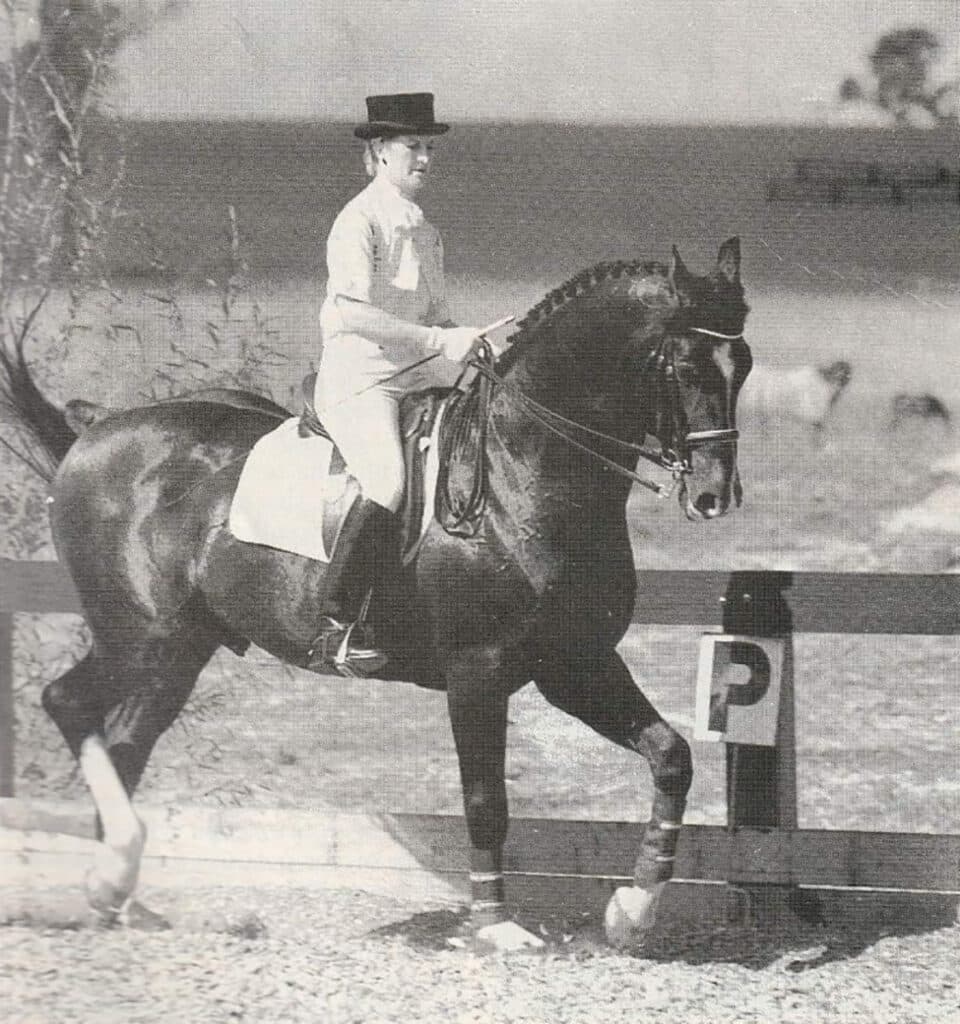
Glennis riding stallion Leonardo 68.
“I had a good time, learnt a lot and had a lot of fun along the way,” Glennis told me. “Some shows with Livius… not so much with Leonardo.” By now she felt it was time to come home and stand on her own two feet, which her father encouraged. “So the horses were both put on a plane and we returned to Australia.”
THINKING BIG AT HORSE WORLD
Glennis’s father Don was a great forward thinker and recognised the need for a great facility where people within the area around Dural could train. They bought a property nearby and proceeded to develop an amazing equestrian facility. They built an indoor arena dug into the ground that was, in its time, the biggest single-span building in the southern hemisphere. Flanked with great seats and facilities for the public and also at right angles to the main arena was a large warm-up arena with an overhead walkway creating a tunnel underneath for the horses to go from the warmup to the main stadium. It truly was a very forward-thinking project and was very well accepted by all in the area and the equestrian fraternity. Glennis had stables at the main house, which flanked the stadium and trained out of that facility every day.
In hindsight, Glennis said, “He would’ve done better building a small indoor arena and a few stables, but no, he wanted to produce a facility that would be recognised Australia-wide as a great initiative and training area for everybody. Typical Don, bigger, better, more! And he wanted to make it outstanding of which it was to be.”
While Glennis was overseas, she collected as much information and photos as she could of all the wonderful facilities there. It was with these instructions and with a fantastic architect and the space they had to work with that the facilities were built from.
Part of Don’s pipedream was also to have a national coach. It was through Leonardo that Glennis met Edgar and Marianne Lichtwark, as they owned that stallion. They were encouraged to come to Australia and to start training out of the equestrian facility that was to be called Horse World and see how it went. Edgar loved Australia and it wasn’t long after that Marianne followed and set up next door to Horse World. Don brought a very beautiful grey horse called Chasseur, who was to be a schoolmaster for the facility at Grand Prix. Edgar had owned and trained that horse in Germany. Edgar was an expert and an all-round equestrian coach, including harness.
To offset costs, Horse World doubled as a recording studio, with acoustics and wiring designed accordingly. Built partially underground for sound quality and natural cooling, it stayed cool year-round. Even Pavarotti visited, attending a showjumping event due to his equestrian interest. The open sides enhanced airflow and temperature control.
After training in Australia at Horse World, Livius and Glennis were on the Australian team at the inaugural 1990 World Equestrian Games in Stockholm, and then the World Cup Final at Gothenburg.
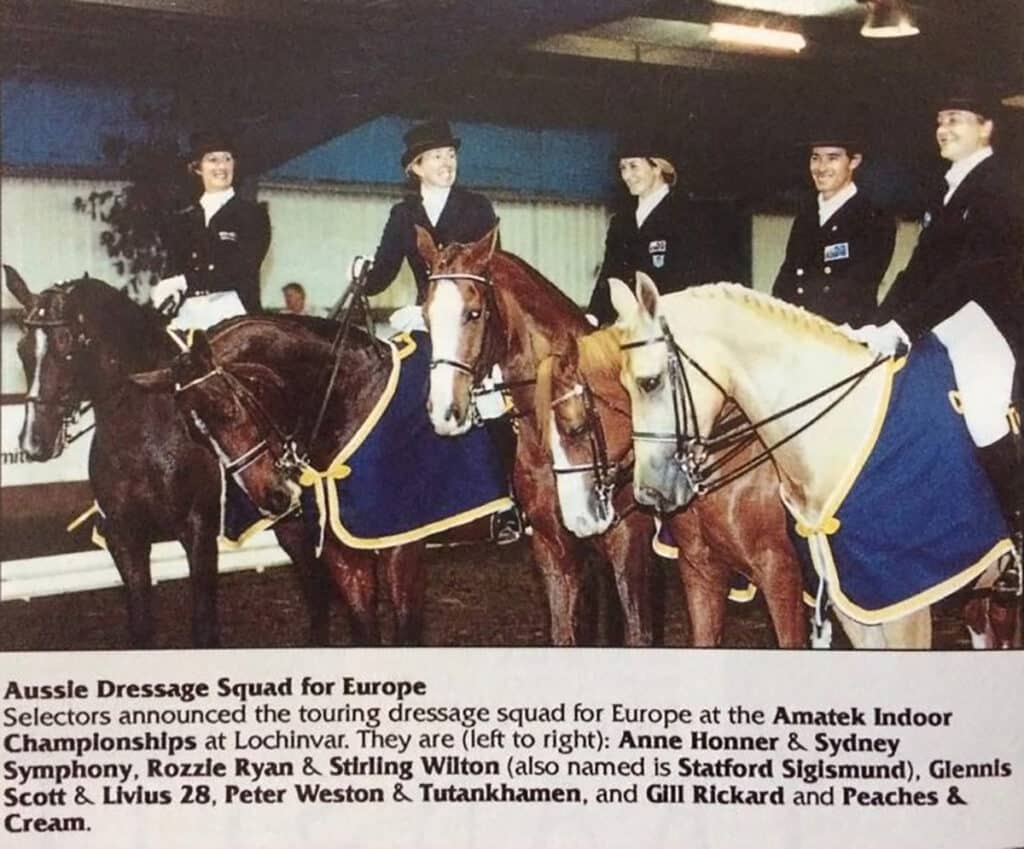
At the 1990 World Equestrian Games in Stockholm, Glennis represented Australia with Rozzie Ryan and Stirling Wilton, Gill Rickard and Peaches and Cream, and Peter Weston and Tutankhamen, with Anne Honner and Sydney Symphony being the reserve.
Glennis spoke about being the qualified combination with Livius to attend the first World Cup Final in Paris, held in 1991.
A LESSON FOR THE FRENCH
The French committee spoke to Glennis, saying they thought that she wasn’t up to it and that it wouldn’t be good for her to come last in the competition. Glennis said she replied, “I’m not going to come last, I’ll probably come 12th! What you guys don’t understand is if you dangle a carrot in front of an Australian and you don’t allow them to have a bite, it is going get you nowhere in the scheme of things. You need to realise that we need to work hard at a sport. We’re not stupid, and we realise we are the underlings, but we deserve the chance to have a tiny nibble at that carrot so that we can get a taste for what may be achievable.”
Glennis also stressed to them that this was the World Cup, not a European Cup, and as a consequence you need to open up to all people from all parts of the world no matter how strong their ability; they need the chance to mix it with the best of the best, and coming last (12th) has really got nothing to do with the overall outcome and encouragement of lesser countries. They conceded that she had made some very valid points, and that she had brought home to them the transparency of the sport, and to be encouraging everyone to get better, as they need opportunities available to them. From here on in, there was no question about encouraging and allowing all countries to compete in the World Cup Final!
On asking Glennis about Livius and the Australian Dressage Championships, she replied, “I believe he won a few national championships at Grand Prix level and I kept those titles – they weren’t taken off me through change of rules!”
REBUILDING FROM SCRATCH
Glennis returned home, and unfortunately, as with a lot of things, Don Scott had gotten a little ahead of himself. Even though he believed financially he could appease everybody, it was not to be. Unfortunately, he ran up too much debt and everything went insolvent.
It was someone in the horse industry who was owed $450 for fencing who became the straw that broke the camel’s back. Glennis remembers it being a very sad time. She was able to keep her horses, but Don was only able to take his clothes with him and a computer. She believed that within a few weeks more, everyone would have had their money, but because of one person who became seriously impatient, the whole property and the whole dream fell apart.
After a while, the Scott family put enough funding together to gain a property on Montpelier Drive in The Oaks, an hour west of Sydney. Glennis then married Simon Barrey and they started working tirelessly to produce a training facility of their own. Don continued in the area he knew well, which was glass, making traffic lights.
Glennis started breeding a few horses under the prefix GB (Glennis Barrey) while also gaining a beautiful bay horse called Calypso Classico, who ended up on national squads at Grand Prix level. She attended clinics with international trainers here, including with Ulla Salzgeber. At The Oaks property, she held popular clinics with Bimbo, whom she brought out to train and help Australian riders. The likes of Matthew Dowsley, Rodney Martin, Maurie and Jane Bruce were all attendees, and this input continued on to make the sport and the riding better and better.
At this time, Classico was proving very successful at Grand Prix with Glennis. Simon also had a showjumping stallion called Fabian, who was by Palachne; Glennis took this horse on also in its dressage career and competed to Small Tour successfully before he was sold to Japan.
Simon and Glennis had a daughter in 1997, Georgina. Georgina is now a very competent rider and also shows horses at national level in hunter classes. Leading up to Grand Prix, Classico won 17 tests in his 19 starts. Classico, or ‘Boy’ as he was known, was schooled from Preliminary all the way through and was on national squads and was a very exciting international prospect.
Unfortunately, after his third Grand Prix test, he had an accident that put him out of action. In true determined form and despite being told it was the end for him, Glennis set about a road to recovery for this wonderful bay gelding.
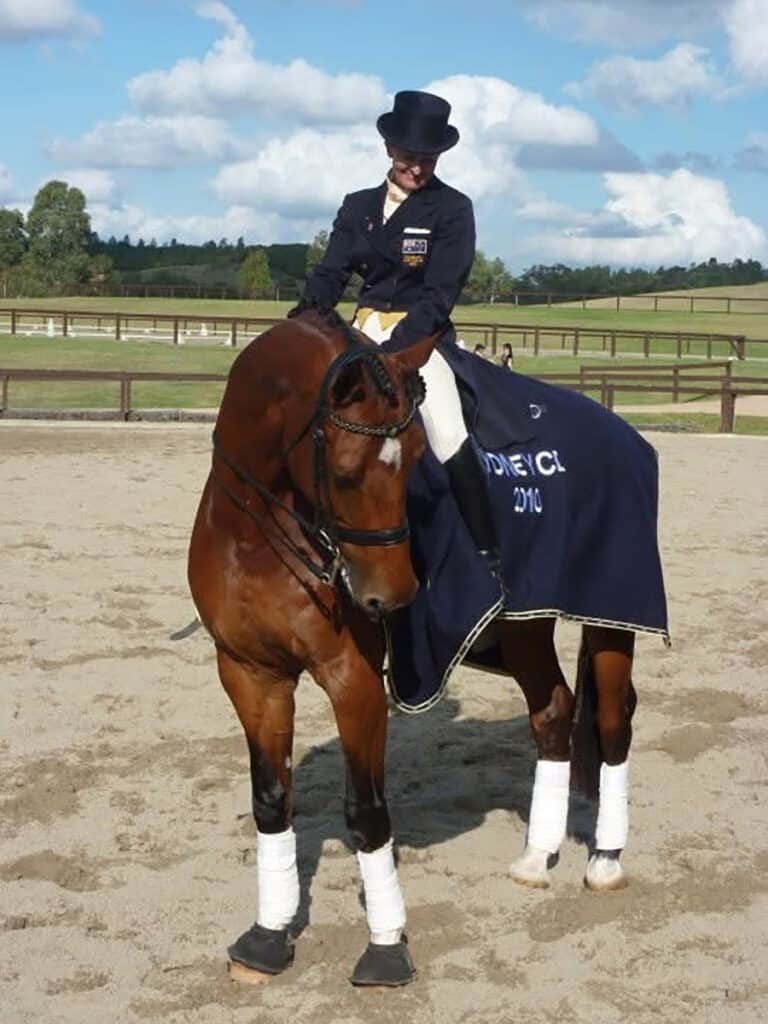
Glennis and Classico at Sydney CDI in 2010.
“It was really like pulling the
rug out from under me…”
GB Saffron was a very well-performed horse through the levels with great success, and this mare was not only a champion ridden horse but bred some successful progeny, including a son that Glennis also competed. But the time had come when she needed a break from the sport and the rigours of a day-to-day agistment centre, training, coaching and riding.
In my conversation with her, she explained, “I was simply burnt out. I had tried my guts out, and I felt I was just treading water trying to help everybody else and not having enough time for own interests and my own self. The definition of madness was doing the same thing over and over and expecting a different outcome, and that wasn’t going to happen so a break was needed. I had a great connection with Classico, and I really struggled when he went lame. It was really like pulling the rug out from under me.
“I also had GB William that I bred by Weltmeyer x GB Saffron who was the super horse, and then when EI [the Australian equine influenza outbreak in 2007] came along when he was at Small Tour, he became sick, and he never really recovered. I was over the disappointment. I felt I was going nowhere, and horses are horses, but I felt I was copping the brunt of bad luck.”
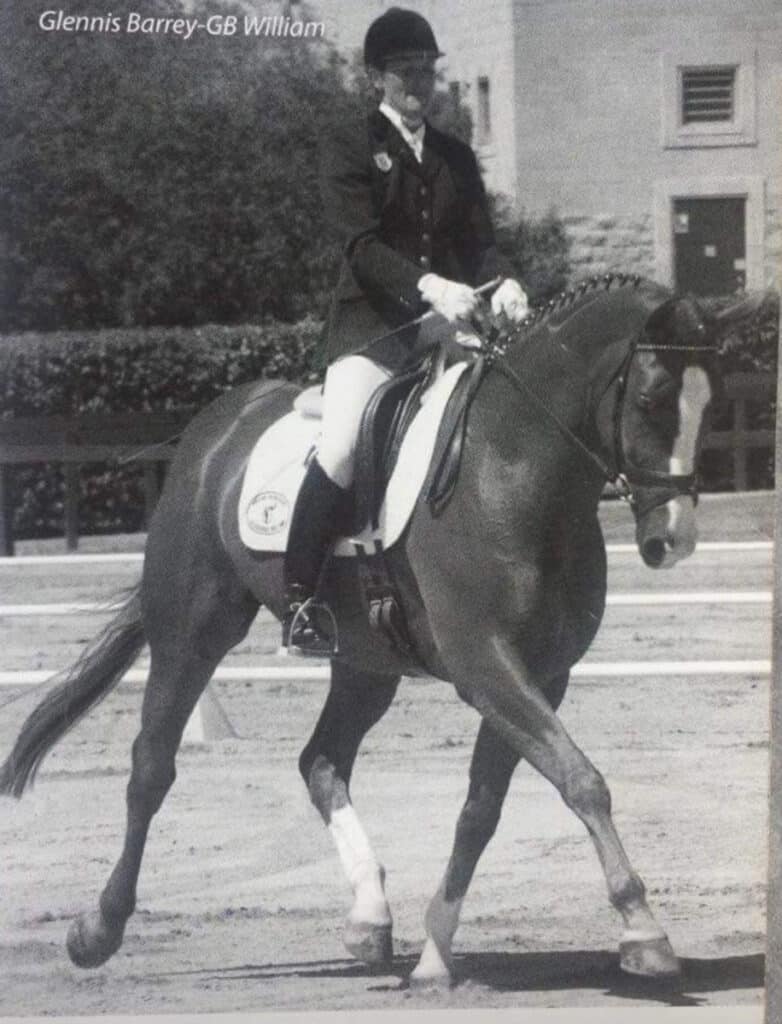
Glennis riding GB William.
TOTAL LIFESTYLE CHANGE
“The lifestyle change was to sell at The Oaks and to move south of Albury to Beechworth – where Max Murtagh, my partner, ran a very successful cafe. I continued to teach and do a few clinics, but nowhere near what I used to do because I was burnt out. I competed on one horse called Sundancer, that was very successful. Max and I saved enough money to purchase a property in Benalla.”
Glennis produced many, many good horses. She bred many good horses, but she realised they all weren’t a world-class standard, and as a consequence she would train them to their best ability and then pass them on to owners that made the most of that good training and breeding and they found their niche, and for Glennis that was very rewarding. The ones she bred by Leonardo weren’t only good types with plenty of colour and conformation prowess, but had fantastic trainable attitudes, and they were very saleable.
At this time Georgina worked in a racing stable near Beechworth where she was an assistant trainer, a very competent horse woman as was her mother.
The next change in Glennis’s life has been fairly tedious and long, as five years ago she was diagnosed with cancer. Feeling unwell, Glennis knew there was something wrong. Despite multiple X-rays and scans and tests and nine doctor’s opinions, she continued on the trail that there was something not right. Finally, it was a doctor in Albury who Glennis went to who said to Glennis, “I’m not sure where to start. I don’t know what is wrong with you.” Glennis, being the down-to-earth sharpshooter suggested, “Let’s start with where the pain is!”
She was sent to a radiographer of great repute and through taking radiographs from a very slightly different angle they found a lump and organised to go to a doctor in Wangaratta to have it removed. It was during a regular preoperative examination that they found exceedingly high serotonin level that was not enabling an anaesthetic procedure to continue. The mass was very small and the surgery very large, and as a consequence the feeling of leaving sleeping dogs be was taken.
In regards to the lump there were several meetings with very well-respected surgeons. It was decided to leave it alone but if ever there was a problem to immediately present and she would have priority. Eventually there was a blockage and Glennis presented to Royal Melbourne Hospital where she was admitted to remove the blockage. Unfortunately, a few days post-surgery there was an infection that was difficult to deal with.
Eight days later, it was emergency surgery to clean out the wound and the intestine. She spent the next six weeks in hospital in agony with them trying to deal with this infection. After battling through this rehabilitation, Glennis returned home and tried to ride and carry on normal life, but the pain was too great to continue in the sport that she loved and she decided it was time to hang up her boots.
Diagnosed with a neuroendocrine cancer, it was new to the oncology departments. Glennis continued to have regular treatment and that treatment would continue, as she said, until the end of time. On asking Glennis how she coped with this she replied: “My life has been an amazing journey. I have had many ups and a few downs but no matter what I have always looked forward to tomorrow and that’s simply the way I think. I know that one day tomorrow won’t be available to me, but until then I intend on making the most of what I can do with my life each day. This cancer has really taken me on an incredible journey and really tries to bring me down.
“I have learnt to accept things in a different light. I’m not stupid and realise my time isn’t long. The FEI tried to shun me back in the day and put me aside… that didn’t happen… many a time judges and people around me have had a go at me. That didn’t stop me. I am ME… I know ME… I am wiser for all the amazing opportunities I have been availed. I know I am determined and single-minded – and some may say selfish – but I think perhaps more protective of my wellbeing, and I stand firmly on my beliefs and direction.
“Life in the world of dressage has made me tough and standalone. I can only say, believe in yourself and follow your dreams. Stand up for yourself and your beliefs and live every day to achieve what you can on that day and look forward to tomorrow. Hasten slowly and look after all those on your side. Surround yourself with positivity until the end.”
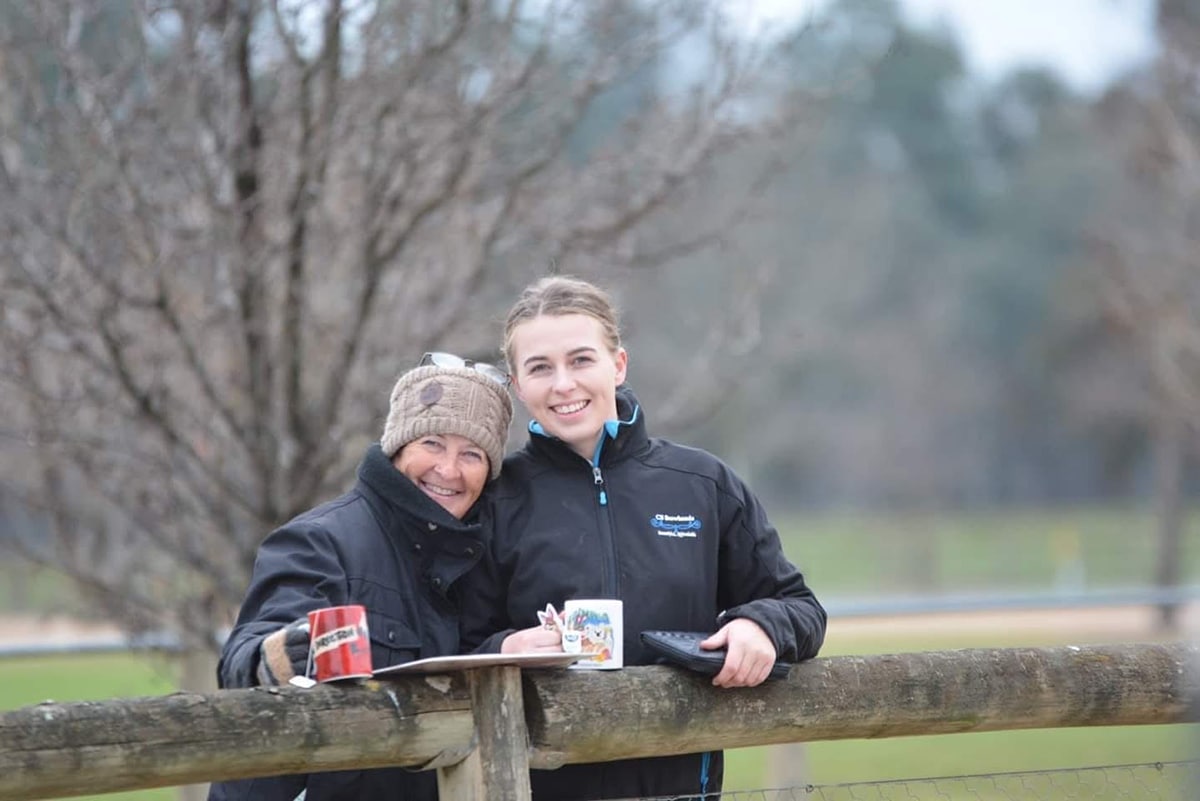
Glennis and daughter Georgina.
After being transferred from the Melbourne cancer medical centre late in July 2025 to a wonderful country hospital back in Benalla near her daughter, Georgie, and Max, she accepted her time was running out. Glennis faced death as she did life: as she faced cantering down the centreline at the World Equestrian Games, World Cup finals, and National Championships to the final halt and salute at X, to simply face the results with total acceptance. She had done all she could for that final halt and all before it.
On Sunday morning, the 20th of July 2025, Glennis halted for that final salute.
Rest easy, Glennis. You faced every day of your life with honesty, positivity, talent, inspiration and a will to succeed and all things in between. You mentored so many. You represented your country with sassiness and a real feeling of pride. You accepted people for who they were with no prejudice. You were a loyal and genuine friend. Your life, successes and influence on so many people is so noticed; your dogged determination that saw such success in life and goals, and especially in your love of horses and dressage, will remain in our hearts forever.
What a life. What a person. You were an inspiration and contributed so much. The end of one special era.
Thank you, Glennis.
